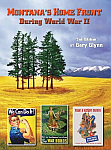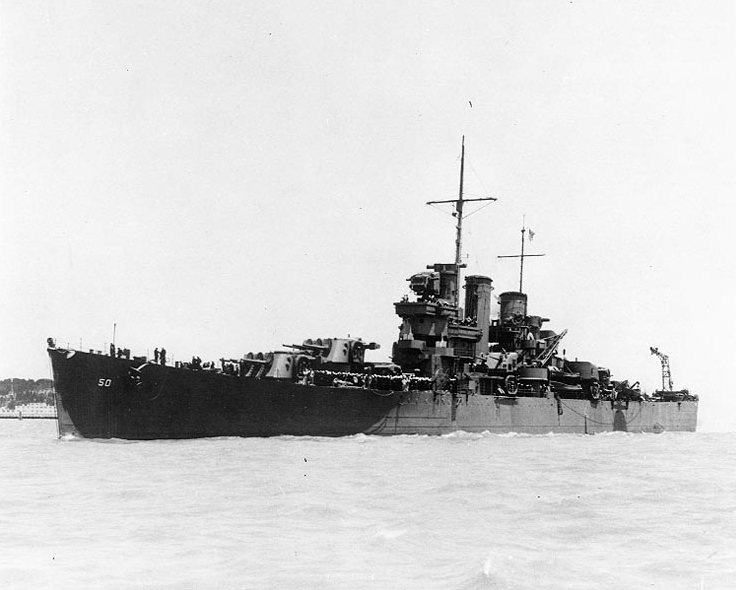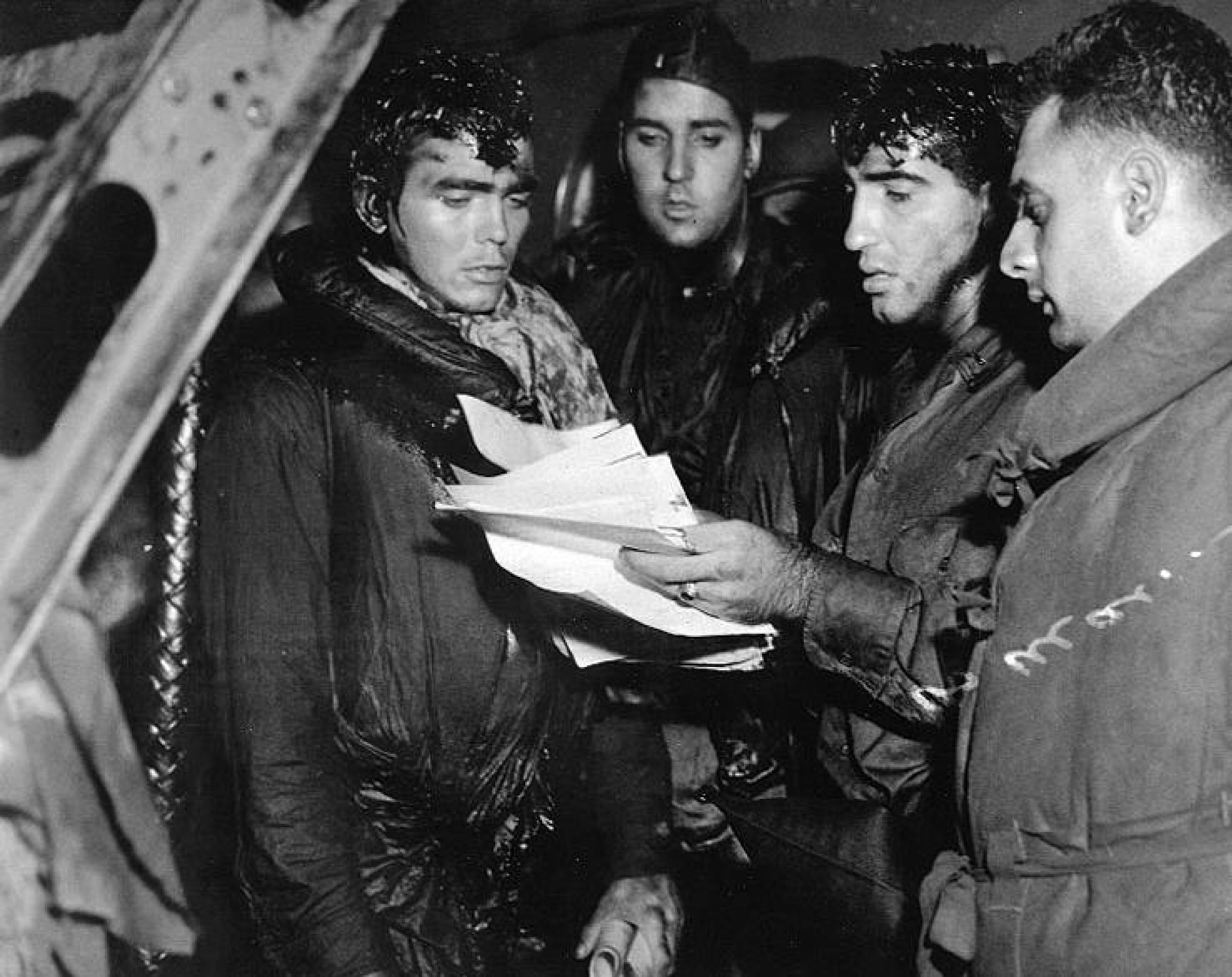Western Montana vets recall their D-Day invasion memories
(this article originally appeared in the Missoulian newspaper June 1994.)

“That spectacle of the D-Day invasion was the greatest action show I have ever witnessed!” Of the 200,000 men who participated in the Normandy invasion on D-Day, George O. Doherty of Missoula had perhaps the best seat in the house. As commander of the 802nd Reconnaissance Group stationed in southeast England, Col. Doherty piloted a specially-equipped, British-built, Mark XVI Mosquito airplane over the invasion beaches.
“It was our mission on D-Day to photograph the invasion by means of four remote-controlled and one hand-held movie cameras.”
“We had received some secret orders which were not to be opened until we got a certain phone call. Well, we got the phone call on the night of the 5th, and they said tomorrow is the invasion.
“Several hundred gallons of paint had been shipped to us in five gallon cans, black and white. They had given us very specific instructions on how to paint the aircraft so it could be identified, friend or foe, on the invasion day.
“Our fighters were not very experienced with recognizing Mosquitoes, so I was very glad to have black and white stripes on the Mosquito. I don’t think I saw a single German airplane, but I was looked over dozens of times by our fighter planes.”
In one night, ground crews painted black and white stripes on all of the 12,000 allied airplanes used on D-Day. Hours before Doherty left his base in southern England, hundreds of planes began warming their engines at airfields all over southern England.
At one of those bases, John Martin and the rest of the troops of the 506th Parachute Infantry, 101st Airborne Division stood on the tarmac, waiting to board the C-47 cargo planes that would carry them into combat for the first time. Martin recalls that, “Eisenhower and Churchill both were on the field the night we boarded the planes. They came around and talked to the guys.”
“As we flew over the Channel, all the ships were there. It was incredible.” Once the planes carrying the paratroopers crossed the French coast, “The place lit up just like a Christmas tree. They had colored flak and tracers and all of that. The airplanes that carried us in had never been exposed to flak before. It scared the hell out of them, that’s all there was to it. They dropped down to treetop level. They dropped us too low. I got the opening shock and then one, two I was on the ground.”
Martin landed in a field full of cows. “We came down somewhere just outside of Ste. Mere Eglise. I figured we were about 30 miles from where we were supposed to be. A lot of our men were hanging on wires and trees. The Germans had shot them right there.”
Paratrooper Albert P. Mayer of the 82nd Airborne Division had two combat jumps under his belt by the time he leaped out of his C-47 in Normandy. Like Martin, Mayer came down near the small French village of Ste. Mere Eglise, the first French town captured by the Allies on D-Day. A house fire illuminated the area as dozens of paratroopers began falling into the village. “There was a guy hanging up in the church tower. I landed just on the other side of him by a farmhouse.”
Startled German defenders opened fire at the paratroopers. “It was frightening,” Mayer recalls. “It was hell, but we came off better than the guys on the beach.” Mayer was a combat engineer assigned to either capture or destroy a bridge leading to Utah beach. “We kept it, but we blew a railroad bridge up, so the Germans couldn’t come down to the beach.”
Ray Grossman of Missoula belonged to the same regiment as Mayer, the 505th Regimental Combat team of the 82nd Airborne Division. A veteran of a previous combat jump on Sicily, Grossman was a parachute artilleryman. His destination was also Ste. Mere Eglise. “We jumped with 75mm pack howitzers, (wrapped in six packages, each with a separate chute) strapped to the bottom of a C-47. There was some anti-aircraft fire coming up at the planes, which was part of the reason why our pilot was trying to make like a fighter pilot. We had a load of cargo that we kicked out the door. The pilot flipped that plane towards the open door, and the load went out, but before we could jump the pilot flipped her back the other way and about dumped us on our rear, so when he flipped her back again, we jumped.”
“I landed well short of the landing zone, in a small tree-lined pasture, with a mare and a small foal. We were issued a small clicker that made a cricket sound to identify friendly troops. I got off about three chirps when that terrified mare came running by and forced me back into the tree line. How could I ever have explained to the kids and grandkids how a country boy who grew up with horses got run over and taken out of the European War before firing a shot.”
After surviving his encounter with the horse, Grossman got another scare. “A glider came in, probably within an hour after I landed, and it landed in the same field as I was in. It gave me a real start, I didn’t hear it until it crashed right near me.”
“As it got lighter we gathered up 50 or so strays from different airborne outfits and headed for Ste. Mere Eglise where the fighting was in progress. I got nicked at Ste. Mere Eglise. I got a flesh wound in my upper arm, took a little chunk out, but it wasn’t anything to incapacitate me. Our mission was to cut off the advance of the Germans to the beach. We were behind enemy lines for five days before our troops relieved us.”
As the paratroopers fought their way through the hedgerows of Normandy, the rest of the invasion force neared the French coast. Packed into more than 5,000 ships, tens of thousands of men nervously prepared for the war’s most dramatic day.
Howard R. Rasmussen of Missoula had a unique perspective of Omaha Beach. He served with the 108th Battalion of seaborne engineers, the SEABEES. In the months leading up to D-Day, his unit in England constructed a giant artificial harbor, code-named MULBERRY. On the night of the invasion his job was to ride aboard one section of the harbor as it was towed across the English Channel.
“They called us, I guess it must have been around one or two in the morning. We saddled up and got on the span. There were five of these spans, five men to a road span, and we rode them with a tugboat pulling on them. They gave us old World War I ’03 rifles, I don’t know what they expected us to do with that.”
“I started getting seasick, but when the firing started, and everything started lighting up, I got scared and I wasn’t seasick anymore. We came under fire half way across the channel.”
“I tell you it was spooky. We saw all those battleships going by, and we thought oh my gosh, here we are right out in the open. That night we had a German E-boat come out, and he was coming right at us. I tell you I was praying something terrible. First time I ever prayed. A Canadian corvette came by and blew the E-boat right out of the water. So the Lord answered my prayers.”
“When we floated in to Omaha beach it was as light as day. We got to the beach after the second or third wave. They didn’t want us to get in there too early and get everything fouled up.
“That’s as far as I went. I’m glad I didn’t get on the beach. Those poor guys, the landing craft would just dump them out, and they had probably eighty pounds on them, and a lot of them were over their heads in the water.”
“I saw three tanks go up the beach, and all three of them blew up. There was a German 88 looking right down on them. Bing, bing, bing, they blew them up. We had a grandstand view. We were bombed and shelled most of the time, but on the third day we got our harbor up and operating.”
Far above Rasmussen, master sergeant Charles E. Stockard, an engineer-gunner on a B-26 Marauder bomber, saw the MULBERRY harbor moving into position. Stockard remembers, “that dock that they built was really impressive.”
In the weeks preceding the D-Day invasion, Stockard’s unit had bombed railroad yards and bridges in France, as well as the distinctive launching pads of Hitler’s secret weapon, the V-2 rocket.
For Stockard, D-Day began at 3:30 a.m. on June 6th. “They got us up early in the morning. We were briefed and at first light of day we took off for Normandy. This was my 61st bombing mission. After we became airborne I could not believe that the Air Force had that number of airplanes in England.”
Stockard’s plane was one of thousands bombing German gun emplacements in the area. “We dropped our bombs on the targets and returned to our air base in England with no damage to our aircraft or crews. While they were debriefing and briefing us, the ground crews were loading up our bombs again.
“I went on my 62nd mission. We again dropped our bombs and returned with no casualties to crew members or aircraft. We dropped all our bombs that day. We didn’t have it too bad on D-Day.”
Raynor T. Roberts of Florence, a 1st lieutenant at the time, was also in the air that day, piloting a P-38 fighter plane of the 474th Fighter-Bomber Group. His mission was to protect the invasion force from air attack. “It was the greatest show on earth–for me anyway. It seemed that one could walk on the ships clear across the Channel and never touch water. The big battleships were shelling Cherbourg and from 3,000 feet one could see the smoking from the 16-inch guns and see the shell hit. As the young generation say now, it was awesome.”
Lt. Col. Doherty was also impressed by the scale of the invasion, but he thought the action below him looked unreal. “It was almost like you would picture Hollywood trying to do. In miniature, you see.”
“The Channel was quite full. All sorts of boats. You could see five or six of them abreast, and they would swing in, you could tell they were counting and measuring off, and were peeling off just like aircraft would. We were able to fairly well tell where the troops were. We could see where Caen was, and could tell that the British hadn’t been able to take that sector.”
“We photographed the invasion fleet and the landing in France for some two hours before returning to our home base.” Doherty didn’t realize the amount of German anti-aircraft fire directed at him until the film was developed. “I was startled when I did see the film, how many flak explosions were behind me. Every time I went over the city of Caen.”
In Missoula, the first announcement of the invasion came when the siren at the Northern Pacific depot on North Higgins let out a long blast at 1:45 a.m. Staffers gathered at the Daily Missoulian to reset the front page and insert the special invasion advertising. The Mercantile (now the Bon) ran a large D-Day ad which showed troops splashing out of a landing craft. It read “LaFayette, we are here… again.”
Within a few hours the streets of downtown Missoula were full of newsboys yelling “extra, extra.” As word of the long-anticipated invasion spread, people began gathering in churches throughout Missoula. The mood was somber, and the Missoula Sentinel (the Missoulian’s afternoon version) reported that on D-Day, “the tremendous import of the news threw a hush over the spirit of the city.”
Glenna Kost Mayer served in the Women’s Army Corps and was working on the atomic bomb project at Los Alamos, N. Mex. when she heard of the invasion in Europe. “We were informed of the events of the landings and other activities of the invasion by a PA system. We were all very concerned and worried about our troops and the outcome of such an endeavor, but it was a great success and we were all grateful to the men who participated.”
She didn’t know that her future husband, paratrooper Albert Mayer, was one of those participating. For Mayer and most of the other men who landed in France on D-Day, the invasion was simply the beginning of a long hard fight across Europe. Mayer was wounded three times. “I got hit on the 3rd of July. They sent me back. Then I got hit over in Holland. In the eye, and they sent me home.” After returning to the United States, demolition expert Mayer was sent to Los Alamos to work on the atomic bomb project, and there he met his future wife, Glenna. After serving in the Korean war and at an air base in Thailand during the Vietnam war, Al Mayer retired from the military. He and Glenna now live in Hot Springs.
Fellow paratrooper Ray Grossman spent a month in Normandy before returning to England. In September 1994, Grossman again went into combat, this time in Holland. “I rode a glider in on that operation. A glider will scare you to death. Jumping was very, very preferable to a glider.” He fought throughout northern Germany and at the end of the war was stationed in Berlin as part of the occupation force in the Nazi capital. He is now a realtor in Missoula.
Paratrooper John Martin, a successful Missoula businessman, survived the Normandy fighting, despite falling asleep in the middle of a firefight. “On the plane on the way over, they gave us each some pills to keep you awake for about three days, soup you up. On the third day we were lying in a hedgerow with bullets flying everywhere. The next thing I knew I was lying there on the ground. I had gone to sleep with the bullets flying over.” Martin also fought in Holland and at Bastogne with the 101st Airborne. The experiences of Martin and the rest of the men of his company have been recorded in a book by noted historian Stephen Ambrose (Band of Brothers, Touchstone Books).
Howard Rasmussen celebrated his 20th birthday on the day after the invasion. He remained at Omaha beach until a massive storm 13 days after D-Day destroyed the American MULBERRY harbor. “They put me on a sunken ship, a breakwater ship. And about that time the storm came up. And that thing was rolling. It was a big ship. Water came up to the deck, finally came up to the poop deck, and we were wading in it. They finally came out and got us. We couldn’t swim off or we would have been finished. That was the worst storm in 50 years they said. Those big battleships were sitting out there, and you would see them come up and then you would see them disappear. And they were only two or three miles away.”
“Then we went inland, after the troops got in, to an orchard I guess, and we stayed there for a couple weeks. After we camped up on the shore, I went out walking, and they didn’t say anything about a password. This guard out there, he said, ‘Give me the password or I’m going to shoot you.’ I said I don’t know it. I was sure he was going to shoot me.”
“Yeah, it was quite an experience. My daughter said why didn’t you go over there and celebrate that, but I said I could cry here just as easily as I could cry over there.”
After the war George Doherty retired from the Air Force and went to medical school, where he became an anesthesiologist. He believes that his airplane filmed, “Most, if not all, of the aerial footage of the D-Day invasion taken by Americans.”
Charles Stockard flew 15 more combat missions over Normandy before returning to the United States in July 1944. After serving 21 years in the military, he moved to Missoula in 1958 and became an Air Force recruiter.
Raynor Roberts also remained in the Air Force and retired with the rank of colonel. He now lives in Florence, and has mixed emotions of the D-Day invasion. “I would never want to have missed it, but I wouldn’t want to do it again.”






